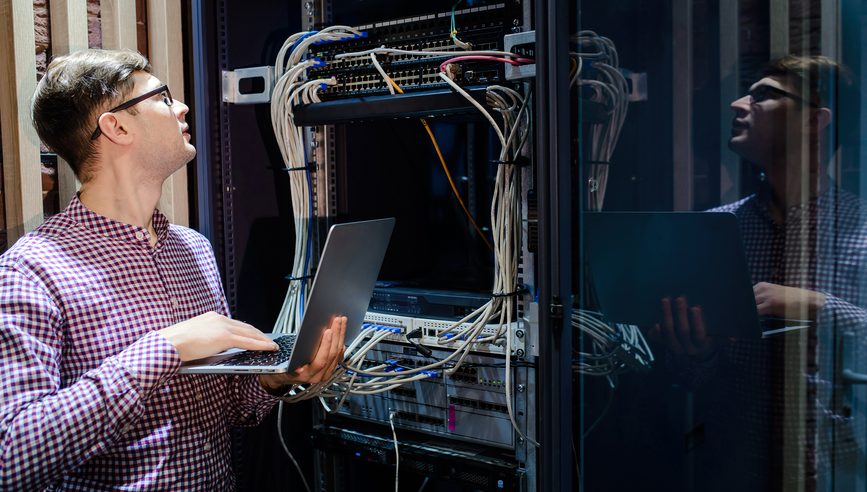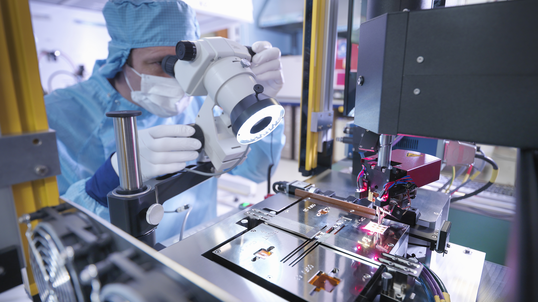Semiconductor Risks Facing Technology and Life Sciences

(MUSIC PLAYING)
(DESCRIPTION)
Travelers Logo
TEXT: Advancing Semiconductors: Rewards and Risks
EMPOWERING THE MIRACULOUS
EMPOWERING THE EXTRAORDINARY
EMPOWERING THE LIFESAVING
EMPOWERING THE AMAZING
EMPOWERING THE INNOVATIVE
EMPOWERING THE WORLD OF TOMORROW
(SPEECH)
RACHEL: The future of semiconductor technology holds vast potential for growth, change and opportunity.
(DESCRIPTION)
TEXT: Rachel Waylander, Stategic Industry Lead Technology & Life Sciences, Travelers
(SPEECH)
I'm Rachel Waylander, Strategic Industry Lead for Travelers Technology & Life Sciences.
(DESCRIPTION)
TEXT: A FUTURE OF GROWTH AND OPPORTUNITY
(SPEECH)
At Travelers, we're excited about what lies ahead.
(DESCRIPTION)
TEXT: Expect continued advancements in power and performance
(SPEECH)
Thanks to 3D integrated circuits, material breakthroughs and more, semiconductors will continue to advance in power and performance, and new innovations spur new applications.
(DESCRIPTION)
TEXT: New innovations will lead to new applications
(SPEECH)
Artificial intelligence powered by advanced semiconductors promises many new opportunities. Everything from satellite communications to drug discovery will feel this impact. But while hardware and software companies relying on semiconductors have much to look forward to,
(DESCRIPTION)
TEXT: THE CHALLENGES OF GEOPOLITICAL, OPERATIONAL AND TECHNOLOGICAL RISKS
(SPEECH)
a range of geopolitical, operational and technological risks offer challenges.
(DESCRIPTION)
TEXT: Highly concentrated semiconductor production presents risks
(SPEECH)
With the global semiconductor supply chain highly concentrated in certain geographies, a disruption could have far-reaching consequences.
(DESCRIPTION)
TEXT: Using unproven suppliers can create liabilities
(SPEECH)
Industries may have to transition to new, unproven suppliers that could introduce product liability and other risks. And because semiconductor functionality must process increasing amounts of data,
(DESCRIPTION)
TEXT: Preparing for cyber risks is key
(SPEECH)
preparing for cyber risks is key.
(DESCRIPTION)
TEXT: EMPOWERING ADVANCEMENTS FOR 40+ YEARS
(SPEECH)
For more than 40 years, Travelers has been at the forefront of protecting and supporting technology and life sciences companies.
(DESCRIPTION)
TEXT: Our capabilities: Product liability, Cyber risk solutions, Global risk solutions.
(SPEECH)
Our capabilities include product liability, cyber and global coverage, plus risk control and claims solutions that meet the specific needs of this industry. Travelers is a key part of empowering the breakthroughs of tomorrow.
(DESCRIPTION)
TEXT: INNOVATE FEARLESSLY. INSURE CONFIDENTLY.
(DESCRIPTION)
Travelers logo
TEXT: To learn more about how we're empowering the tech & life sciences industry, visit travelers.com/semiconductors
Travelers Indemnity Company and its property casualty affiliates. One Tower Square, Hartford, CT 06183.
This material does not amend, or otherwise affect, the provisions or coverages of any insurance policy or bond issued by Travelers. It is not a representation that coverage does or does not exist for any particular claim or loss under any such policy or bond. Coverage depends on the facts and circumstances involved in the claim or loss, all applicable policy or bond provisions, and any applicable law. Availability of coverage referenced in this document can depend on underwriting qualifications and state regulations.
© Copyright 2024 The Travelers Indemnity Company. All rights reserved. Travelers and the Travelers Umbrella logo are registered trademarks of The Travelers Indemnity Company in the U.S. and other countries.
The world relies on semiconductors – integrated circuits made from semiconductors are the brains behind modern technology, from the smartphone in your pocket to the powerful computers driving scientific breakthroughs. As the industry pushes boundaries, it unlocks a future filled with potential: faster and more complex processors fueling developments in electronics, lifesaving medical advancements and more. Yet alongside these exciting opportunities are risks that threaten to slow or even halt progress in its tracks.
"Navigating the semiconductor risk landscape is complex and requires awareness and preparation," said Rachel Waylander, Strategic Industry Lead, Travelers Technology & Life Sciences.
The geographic concentration of specific expertise and manufacturing across the world, coupled with vulnerabilities from natural disasters, geopolitical tensions and supply chain disruptions, creates a complex global risk environment for technology and life sciences companies.
Global risks loom large
While the semiconductor industry spans the globe with players involved in design, manufacturing and assembly across continents, it still has a surprising level of geographical concentration. This concentration, particularly in specific countries for chip fabrication, production of certain critical materials and sophisticated software design, creates a single point of failure vulnerability. This fragility manifests in multiple ways, from natural disasters impacting key production centers to geopolitical tensions disrupting trade flows.
Semiconductor technology vulnerabilities in four critical sectors
“Trends, global risk challenges and opportunities impact the semiconductor industry and its influence on four key sectors: electronics manufacturing, life sciences, telecom and information technology,” said Waylander. Technology errors and omissions (E&O) insurance is often overlooked, yet it’s crucial for many technology companies because of the consistent industry changes and developments.
1. Life sciences
Semiconductor technologies are revolutionizing the life sciences industry, transforming the way we diagnose, treat and monitor patients. Implantable sensors can now track our health in real time, but this reliance on chips also introduces new risks. "Life Sciences Companies Face New Risks with Semiconductors" explores the exciting potential of semiconductors in healthcare, along with the potential risks and how to mitigate them.
2. Electronics manufacturing
The electronics industry thrives on specialized chips for AI, EVs and 5G, but semiconductor manufacturing’s complex global supply chain poses risks. "3 Semiconductor Risks to Electronics Manufacturers" explores three key concerns: product failures due to chip complexity, geographic concentration at risk from geopolitical or weather disruptions, and rising cyber threats. Proactive risk management and insurance solutions from Travelers help navigate these challenges.
3. Telecommunications
Integrated circuits are crucial for telecom, but their potential for scarcity and other vulnerabilities expose networks to risks. Supply chain disruptions, cybersecurity threats and weather damage are key concerns. "How Telecommunications Businesses Manage Semiconductor Risks" emphasizes risk mitigation: developing business continuity plans, investing in cybersecurity and forming relationships with alternate hardware suppliers. Insurance solutions from Travelers can also help manage risks and ensure a secure, reliable and connected future.
4. Information technology and software
The explosive proliferation of AI chips creates vulnerabilities for software developers. Bottlenecked research & development due to potential hardware shortages, hidden cybersecurity threats within chips and potential project delays due to hardware procurement delays all threaten productivity. "Software Developers Beware of IT Risks from Semiconductors" looks at alternatives for sourcing hardware for testing, diversifying supply chains, prioritizing transparency and conducting proactive software/hardware security audits.
Implementing software risk management best practices and insurance solutions from Travelers can help software developers and IT companies manage semiconductor risks.
Explore how semiconductor risks affect these industries:
Life Sciences Companies Face New Risks with Semiconductors
Semiconductors are essential for medical advancements, yet this reliance creates risks. Learn strategic insights to navigate complexities and ensure resilience.

3 Semiconductor Risks to Electronics Manufacturers
Semiconductors are essential to advanced electronics manufacturing, yet this reliance creates increased risks.
How Telecommunications Businesses Manage Semiconductor Risks
Delve into Travelers’ analysis of semiconductor risks in telecommunications. Gain insights to mitigate potential challenges and ensure resilience in the industry.

Software Developers Beware of IT Risks from Semiconductors
Explore Travelers’ thorough findings on IT and semiconductor risks. Stay ahead in the fast-paced tech industry with expert guidance and proactive solutions.




